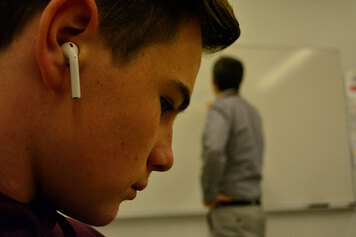In order for our students to be good learners, having the ability to focus, direct and maintain one's attention is fundamental. Like the old adage, lights are on but no one’s home, without presence, the greatest teachers will fail to shape our student’s minds or challenge their beliefs. But this isn’t just about dealing with shortened attention spans.
Last spring, I was invited to teach a 6-week mindfulness program at a local high school and faced something even more daunting: Students had free use of cell phones and headphones during classroom instruction. From the moment kids wandered in until the time my lesson was over, eye contact with them was rare. Even after the teacher warned that technology was off limits, there was no strict enforcement when students reverted back to their music, texting and even gaming, sound effects and all. I often felt invisible. A teacher explained to me that for some students, school was an escape from their struggles at home and just getting there was all they could manage. When I asked what would happen to these kids who would eventually fail or finish school with no real education, the answer was, they’d figure it out. This response and the students’ responses to me were, to say the least, discouraging. I have compassion for students’ challenges in life. However, is it in their best interest, to expect so little of our students that they shouldn’t be required to tune in when a lesson is being taught or to pay attention when someone is speaking to them? If we set the bar so low for our kids, only a few may rise to their potential. Perhaps the issue of technology will become an explicit part of my mindfulness curriculum. What’s it like when we set our phones aside and become present? How can that benefit all of us? --K. Ervin Comments are closed.
|
Categories
All
Archives
July 2024
|
Make a difference.
|
Copyright © 2020 Michigan Collaborative for Mindfulness in Education


 RSS Feed
RSS Feed

